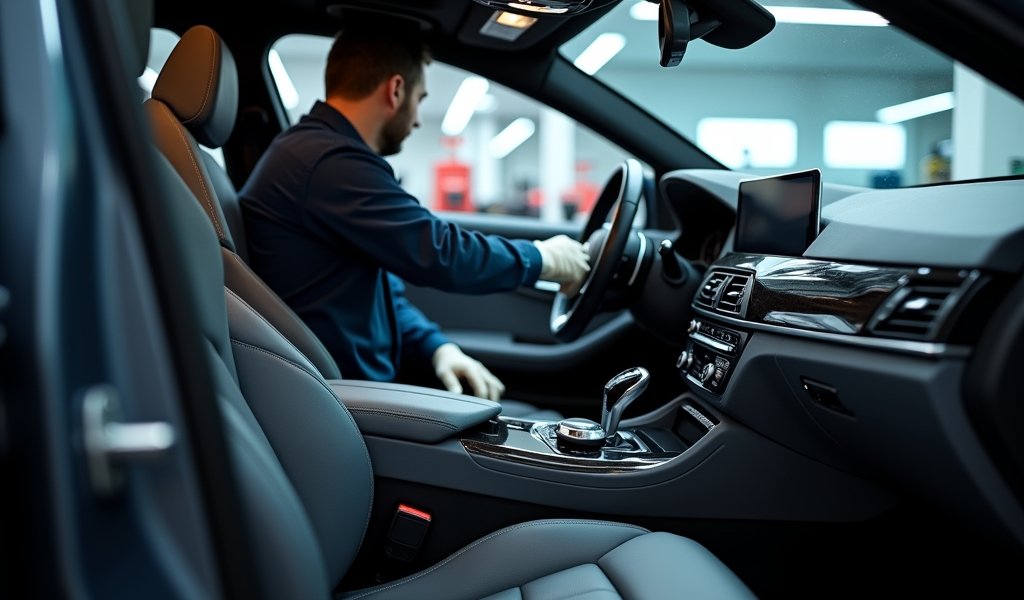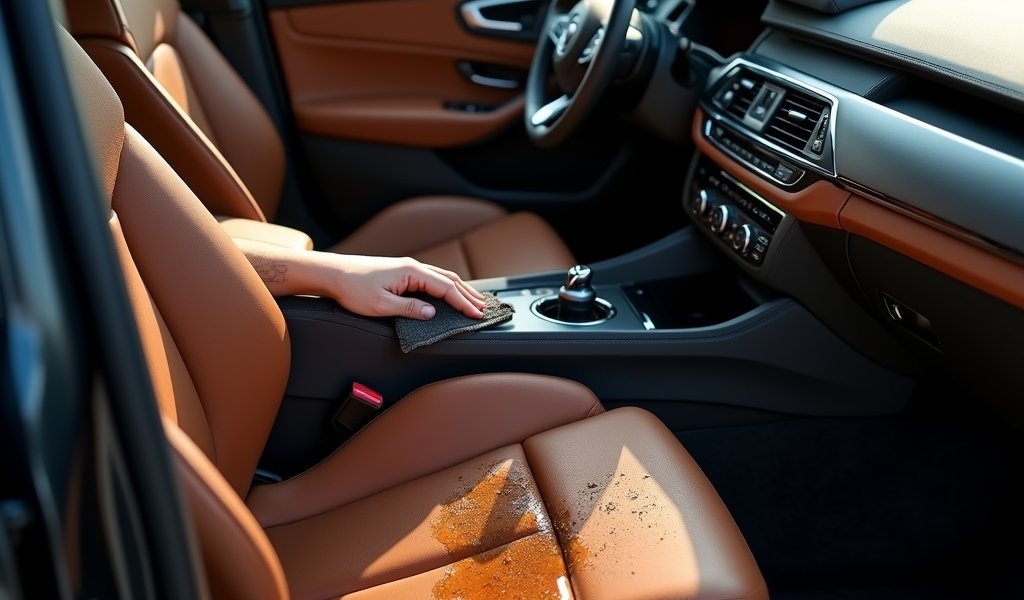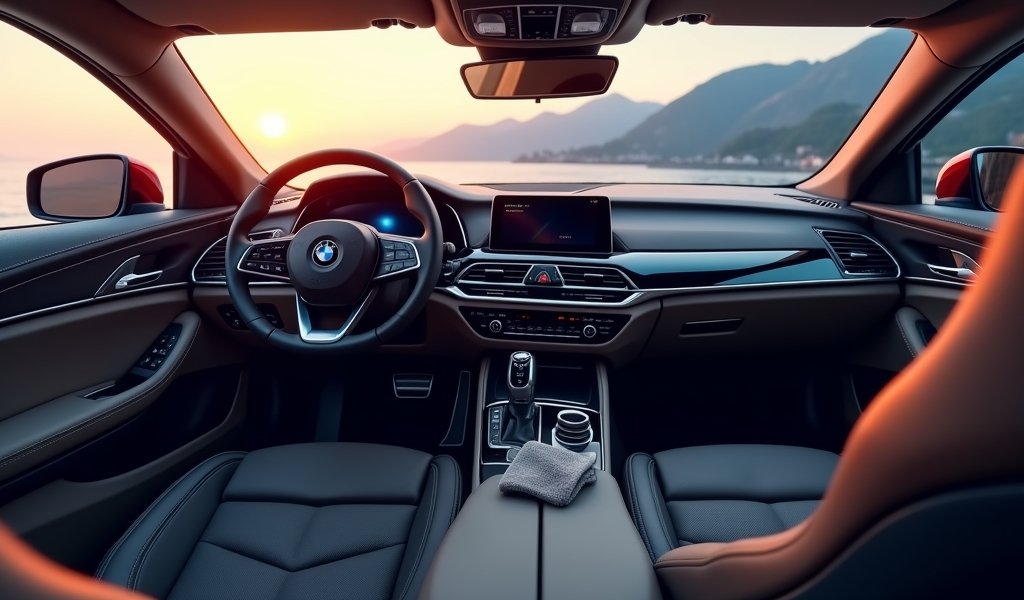Overview
Car interior ceramic coating creates a durable, hydrophobic layer that protects surfaces from stains, UV damage, and wear while reducing cleaning time and maintaining your vehicle’s appearance. The article provides step-by-step guidance on proper preparation, application techniques, common mistakes to avoid, and long-term maintenance strategies to achieve professional-quality results that last 1-2 years.
Table of Contents
- Introduction to Car Interior Ceramic Coating
- What Is Car Interior Ceramic Coating?
- The Benefits of Ceramic Coating Your Car’s Interior
- Preparing Your Car Interior for Ceramic Coating
- Perfect Application Techniques
- Common Mistakes to Avoid
- Maintaining Your Ceramic Coated Interior
- Conclusion
- Frequently Asked Questions
Introduction to Car Interior Ceramic Coating
Picture this: you’re sipping your morning coffee, rushing to work when suddenly – spill! Your pristine car upholstery now sports a brown stain that’ll remind you of this Monday morning mishap for years to come. We’ve all been there. But what if I told you there’s a solution that could have prevented that permanent reminder of your clumsy moment?
Car interior ceramic coating is the unsung hero of vehicle protection that’s finally getting the recognition it deserves. As someone who’s spent decades under the hood and inside countless vehicles, I can tell you that protecting your car’s interior is just as crucial as maintaining that glossy exterior shine.
In today’s guide, I’m sharing my top professional tips for applying and maintaining a ceramic coating on your car’s interior surfaces. These aren’t just theoretical recommendations – they’re tried-and-tested techniques I’ve refined over years of hands-on experience. Whether you’re looking to preserve your new car’s showroom feel or rejuvenate an older vehicle’s cabin, these insights will help you achieve professional-grade results.
What Is Car Interior Ceramic Coating?
Before we dive into the how-to, let’s clarify what we’re talking about. Car interior ceramic coating isn’t just another fancy name for interior detailer or protectant – it’s a revolutionary approach to preserving your vehicle’s cabin.
At its core, a ceramic coating is a liquid polymer that chemically bonds with the surface it’s applied to, creating an invisible but durable layer of protection. Unlike traditional protectants that sit on the surface, ceramic coatings integrate with the material at a molecular level, offering substantially longer-lasting protection.
The science behind it is fascinating. These coatings contain silicon dioxide (SiO2) or titanium dioxide (TiO2) nanoparticles that form a semi-permanent bond with surfaces, creating a hydrophobic barrier that repels water, resists UV rays, and prevents stains from setting in. According to research published in Scientific Reports, these nanoparticle coatings can maintain their protective properties for years rather than months.
When applied to your car’s interior surfaces – from leather and vinyl to plastic and fabric – ceramic coating creates a protective shield that’s resistant to spills, UV fading, and everyday wear. It’s like giving your interior surfaces their own invisible force field against the chaos of daily life.

The Benefits of Ceramic Coating Your Car’s Interior
Why should you consider ceramic coating your car’s interior? Let me break down the compelling advantages that make this investment worthwhile:
Superior Stain Resistance
Coffee spills, food droppings, makeup accidents – life happens inside your car. With ceramic coating, liquids bead up rather than absorb into surfaces, giving you precious extra seconds to wipe them away before they become permanent stains. This hydrophobic quality is particularly beneficial for fabric seats and carpets, which are notoriously difficult to clean once stained.
UV Protection That Lasts
The sun’s rays are relentless on your car’s interior, especially if you park outdoors regularly. Over time, UV exposure can cause fading, cracking, and deterioration of your dashboard, seats, and door panels. Ceramic coating contains UV inhibitors that significantly reduce this damage, preserving your interior’s color and preventing premature aging.
I’ve seen firsthand the difference in two identical vehicles after five years – one with protected surfaces and one without. The contrast is startling, particularly on leather and vinyl surfaces which are especially vulnerable to UV damage.
Simplified Cleaning Routine
Perhaps my favorite benefit is how ceramic coating transforms your cleaning routine. Dust and dirt have a harder time adhering to treated surfaces, which means less frequent cleaning. And when you do clean, it’s a breeze – most debris wipes away with minimal effort. Many of my clients report cutting their interior cleaning time in half after applying ceramic coating.
When you detail your car interior like a pro, ceramic coating helps maintain that showroom-fresh look for months, not just days.
Extended Lifespan of Interior Materials
Your car’s interior components face constant abuse – from the friction of getting in and out to the oils from your skin. Ceramic coating creates a barrier that reduces wear on these surfaces. This protection is especially valuable for leather seats, where it prevents the natural oils in the leather from drying out while also blocking body oils and sweat from being absorbed.
Enhanced Appearance
Let’s not forget the aesthetic benefits. Ceramic coatings add a subtle enhancement to interior surfaces – not a glossy, artificial shine, but a natural-looking depth and richness to colors and textures. Leather looks more supple, plastics appear newer, and the overall impression is one of meticulous care.
Preparing Your Car Interior for Ceramic Coating
The success of your ceramic coating project hinges on proper preparation. Skipping or rushing this step is like building a house on sand – the results won’t last. Here’s my professional approach to preparing interior surfaces:
Thorough Cleaning Is Non-Negotiable
Start with a deep clean that goes beyond the surface. Any contaminant left behind will be sealed under the coating, becoming a permanent feature of your interior. I recommend a multi-step process:
- Vacuum thoroughly, using crevice tools to reach every nook
- Remove any seat covers or floor mats for separate cleaning
- Use appropriate cleaners for each surface type (leather, vinyl, fabric, plastic)
- Address any stains with targeted treatments before proceeding
- Clean air vents with compressed air and detail brushes
For hard surfaces like dashboards and door panels, I’ve found that an isopropyl alcohol (IPA) solution (diluted to around 15%) works wonders as a final wipe-down. It removes any residual cleaner and oils that might interfere with the coating’s ability to bond.
Surface Inspection Under Proper Lighting
Before applying any product, inspect all surfaces under bright, preferably natural lighting. Look for any missed spots or stubborn residue. I often use a detailer’s inspection light to catch imperfections that normal cabin lighting might hide.
Remember, ceramic coating will magnify the current condition of your surfaces – it won’t hide imperfections. If you find scuffs, scratches, or damage, address these issues before coating.
Temperature and Environment Considerations
The ideal environment for applying interior ceramic coating is:
- Temperature between 65-75°F (18-24°C)
- Low humidity (below 65% if possible)
- Dust-free environment
- Indirect lighting to spot missed areas
I advise working in a garage with the doors closed to minimize dust contamination. If that’s not possible, at least park in a shaded area away from wind and direct sunlight.
Masking and Protection
Take time to mask off any areas where the ceramic coating shouldn’t go – electrical components, screens, speakers, and any porous materials that won’t benefit from the treatment. Painter’s tape works well for this purpose. This precaution saves a lot of headaches later.
When detailing your car comprehensively, proper surface preparation ensures your ceramic coating will deliver its full potential.
Perfect Application Techniques
With your interior properly prepared, it’s time for the main event: applying the ceramic coating. This process requires patience and attention to detail, but the results are worth it. Here’s how to get it right the first time:
Selecting the Right Products
Not all ceramic coatings are created equal, especially when it comes to interior applications. Look for formulations specifically designed for interior surfaces. These typically have:
- Lower SiO2 content than exterior coatings (usually 30-50%)
- Specific formulations for different materials (leather, fabric, plastic)
- Low or no VOCs for safety in enclosed spaces
- UV protection additives
My personal recommendation is to invest in quality over quantity. A premium product from established manufacturers like Gtechniq, CarPro, or Gyeon’s interior line will deliver better results than cheaper alternatives.
The Right Tools Make All the Difference
Gather your application tools before starting:
- Several microfiber applicator pads (one for each surface type)
- Lint-free microfiber towels for removal
- Nitrile gloves to protect your hands and prevent oils from contaminating surfaces
- Small foam brushes for tight areas and crevices
- Good lighting setup (a headlamp works wonders)
Pro tip: I wrap my applicator pads in a suede microfiber cloth secured with a rubber band. This creates a smooth application surface and prevents the pad from absorbing too much product.
Systematic Application Process
Work in small sections and follow this process:
- Apply 4-5 drops of coating to your applicator (never directly to the surface)
- Use straight, overlapping motions to ensure even coverage
- Watch for high spots or pooling and immediately level them out
- After 1-2 minutes (or according to product instructions), lightly buff with a clean microfiber cloth
- Move to the next section, slightly overlapping with the previous area
Start from the top of your interior and work down – headliner (if applicable), dashboard, door panels, center console, then seats and carpets last. This prevents dust or lint from falling onto already coated surfaces.
Special Considerations for Different Surfaces
Each surface in your car’s interior requires a slightly different approach:
Leather: Apply thin, even coats and buff thoroughly. Too much product can make leather feel stiff or unnatural. Two light coats are better than one heavy application.
Plastics and Vinyl: These surfaces typically accept coating very well. Ensure you get into all the texture and grain for complete coverage.
Fabric and Carpets: Use dedicated fabric coatings and apply with a gentle misting technique rather than direct application. Allow longer cure times for these more porous materials.
Screens and Displays: Generally, I advise against coating touchscreens and displays. The risk of issues outweighs the benefits. If your coating product specifically mentions compatibility with screens, follow the manufacturer’s instructions precisely.

Common Mistakes to Avoid
In my years of working with ceramic coatings, I’ve seen plenty of avoidable errors. Learn from others’ mistakes to ensure your project goes smoothly:
Rushing the Cure Time
Patience is truly a virtue when it comes to ceramic coating. One of the biggest mistakes I see is people using their vehicle before the coating has fully cured. Depending on the product, complete curing can take anywhere from 24 hours to 7 days.
During this time, avoid:
- Eating or drinking in the vehicle
- Using chemical cleaners or protectants
- Excessive humidity (don’t leave windows down if it’s foggy or rainy)
- Extreme temperatures
For optimal results, I recommend parking your car in a garage with stable temperature and humidity for the duration of the curing period. If that’s not possible, at least avoid conditions that might interfere with proper curing.
Over-Application
When it comes to ceramic coating, less is definitely more. Applying too much product leads to:
- High spots and uneven appearance
- Longer, more difficult buffing process
- Potential tacky feeling that never fully cures
- Waste of expensive product
A few drops on your applicator should cover a surprisingly large area. If you find yourself using excessive product, you’re likely applying too much.
Missing Critical Areas
Some areas are easily overlooked but benefit greatly from ceramic coating:
- Steering wheel (a common high-wear area)
- Gear shifter and surrounding console
- Door jambs and thresholds
- Under seat rails where dust accumulates
- Air vent slats
Use a systematic approach and good lighting to ensure complete coverage. I like to mentally divide the car into zones and check each one off as I complete it.
Ignoring Product Compatibility
Not all products work well together. Before applying ceramic coating, ensure any previous treatments or conditioners are fully removed. Some common conflicts include:
- Silicone-based dressings and ceramic coatings
- Oil-based leather conditioners and water-based ceramics
- Some factory-applied protectants and aftermarket coatings
When in doubt, perform a small spot test in an inconspicuous area and wait 24 hours to check for adverse reactions.
Maintaining Your Ceramic Coated Interior
Applying ceramic coating isn’t a “set it and forget it” solution. While it dramatically reduces maintenance requirements, some care is still needed to maximize its lifespan and performance:
Regular Cleaning Protocol
With ceramic coated surfaces, your cleaning routine should change slightly:
- Use pH-neutral cleaners specifically designed for coated surfaces
- Avoid alcohol-based products that can degrade the coating over time
- Microfiber towels are your best friend – avoid rough cloths or paper towels
- For quick cleaning, a damp microfiber often works without any product
I recommend a weekly quick wipe-down and a more thorough cleaning monthly. The beauty of ceramic coating is that most dirt won’t adhere strongly, making cleaning much faster and easier.
Long-Term Protection Strategies
To extend the life of your ceramic coating:
- Use a quality sun shade when parked outside for extended periods
- Consider ceramic coating boosters every 6-12 months
- Address spills immediately before they can penetrate the coating
- Avoid using interior wipes containing silicone or other additives
Even with the best ceramic coating, using proper techniques after washing will help maintain its effectiveness.
When to Reapply
Depending on usage and care, interior ceramic coatings typically last 1-2 years before a full reapplication is necessary. Signs that it’s time to reapply include:
- Water no longer beads effectively on surfaces
- Stains becoming harder to remove
- Surfaces starting to look dull or uneven
- Dirt adhering more readily than before
When these signs appear, it’s time to start the process again. The good news is that reapplication is often easier than the initial coating as the surfaces are likely in better condition than they were originally.
Conclusion
Ceramic coating your car’s interior is one of the smartest investments you can make to preserve its value and enhance your ownership experience. The initial time investment pays dividends in reduced maintenance, superior protection, and preserved appearance for years to come.
Remember that success lies in the details – proper preparation, quality products, careful application, and consistent maintenance. Follow the professional tips I’ve shared, and you’ll achieve results that rival those from expensive detailing shops.
Your car’s interior is where you spend all your driving time. With ceramic coating protection, that environment will remain cleaner, look newer, and feel better for the long haul. Whether you’re preserving a new vehicle or rejuvenating an older one, these invisible shields of protection are worth every minute of effort they require.
Have you applied ceramic coating to your car’s interior? I’d love to hear about your experience in the comments below. And if you have any questions about the process, don’t hesitate to ask – I’m here to help you achieve the best results possible.
Frequently Asked Questions
How long does interior ceramic coating last?
With proper maintenance, interior ceramic coatings typically last 1-2 years before requiring reapplication. High-wear areas like steering wheels and door handles may need refreshing sooner.
Can I apply ceramic coating to fabric car seats?
Yes, but you need a specialized fabric ceramic coating product. These formulations create hydrophobic protection without changing the texture or breathability of the fabric.
Will ceramic coating make my dashboard shiny?
Quality ceramic coatings enhance the natural finish rather than adding artificial shine. The result should be a clean, restored look that matches the original appearance of your dashboard.
Can ceramic coating fix scratches on interior trim?
No, ceramic coating will not repair or fill scratches. In fact, it may make minor scratches more visible, which is why proper preparation and addressing imperfections beforehand is crucial.
Is interior ceramic coating safe for touchscreens?
Generally, I don’t recommend coating touchscreens unless the product specifically states it’s safe for this application. Many screens have factory coatings that could be compromised by additional treatments.

